
Volume 53 - Spring 2022
J Hewit & Sons: A Company History
Part 4 - 1868-1886 by Roger Barlee
In 1868 Janet Hewit, the matriarch who ran the business on her own for the best part of 10 years died aged 61. In her later years she had worked as matron at the Trade Maidens Hospital in Argyle Square (now gone). By this stage Janet's three sons Thomas (38) David Gavin (32) and Charles Murray (26) were running the business.
Following the fire, the tannery in the High Street was not only rebuilt but also expanded in size and height. We are lucky to have photographs of the premises in 1870 and 1871 showing the building before they were obscured by the building of tenements on the new Jeffrey Street that runs under Edinburgh's North Bridge parallel to Waverley Station. Further buildings were added over the decades but these buildings were the main structure that was there until the tannery moved to Currie in 1969.
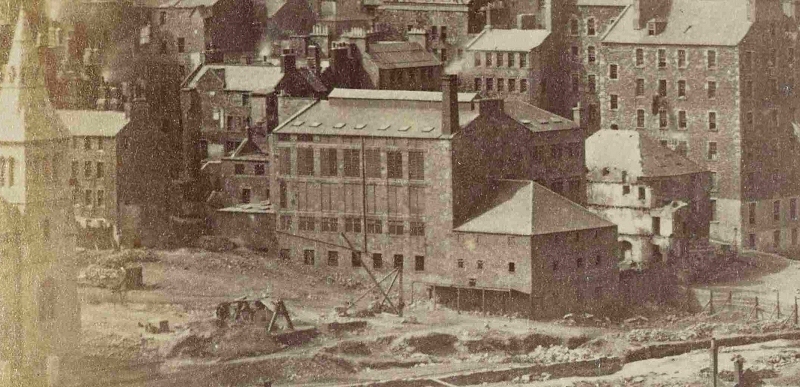
City Tan Works in 1870
We know that in the late 1870s or early 1880s, Hewits also built right down to Jeffrey Street with a four storey working department plus a beautiful 5 storey warehouse fronting onto Jeffrey Street. This was a substantial development 50 feet wide by 150 feet in depth. According to the Edinburgh Courant this building was in the "old Scottish baronial style and embellished with figures illustrating the trade carried on therein". The upper two floors were rented out as dwelling houses with the tannery using the lower three floors. The first floor contained sole leather and an engine (probably for grinding bark) with the third floor holding stock of soft leather and bookbinding cloth.
This whole structure was destroyed in the biggest fire Edinburgh had seen for many years on the 1st of June 1884 with thousands of people crowding onto North Bridge to watch the spectacle. The fire was finally extinguished with the help of 8 hoses and a change of wind direction. According to the Edinburgh Courant the damage amounted to £25-30,000, approximately £2.5-3 million in today’s money.
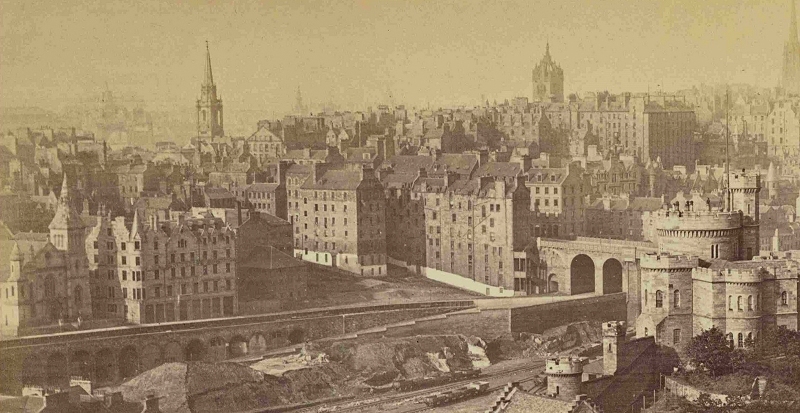
City Tan Works in 1871 (in shadow) - North Bridge arches to right
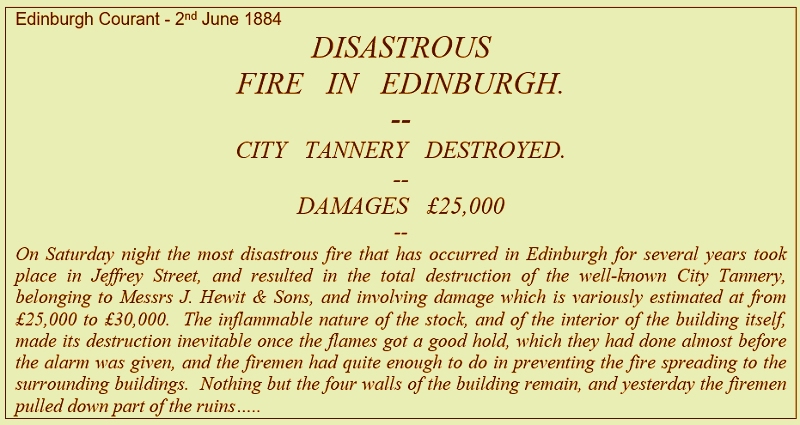
I have seen the plans for the replacement warehouse but with the deaths of Thomas Hewit in 1886 and David Gavin Hewit in 1887 these were never executed and the land was sold off in 1888.
Thomas, David Gavin and Charles had big plans and in 1870 they purchased the tannery and leasehold of Learmonth and Roberts at 98 Pages Walk, Bermondsey along with the head office at 24 Bride's lane, Fleet Street London. Learmonth and Roberts was a long established leather firm that according to the Leather Trades Circular and Review had been established nearly 100 years. Mr. Thomas Young Learmonth, who died in 1866, appears to have been the last partner running the company and it was subsequently put up for sale in 1869. By purchasing a tannery in Bermondsey along with a head office in Bride Lane, the brothers were very much putting themselves forward as one of the leading tannery families in the UK.
David Gavin Hewit appears to have taken over the running of the London operations with his two brothers staying in Edinburgh. He lived in a house in Upper Norwood, a very fashionable area in south west London close to the Crystal Palace.
By chance I have managed to locate detailed plans of the site in Pages Walk. From this it can be seen that Learmonth and Roberts tannery was certainly more spacious than the confined space in Edinburgh. The 1881 census stated that the tannery had 100 men and boys so the purchase of a second tannery in 5 years was definitely a leap of faith in the future of leather tanning. The map of the site shows that it included extensive liming and tanning pits (the small squares) along with a shaving shed, dyehouses, and a large area of warehousing and probably looked very similar to the picture of Grange Tannery less than half a mile away.
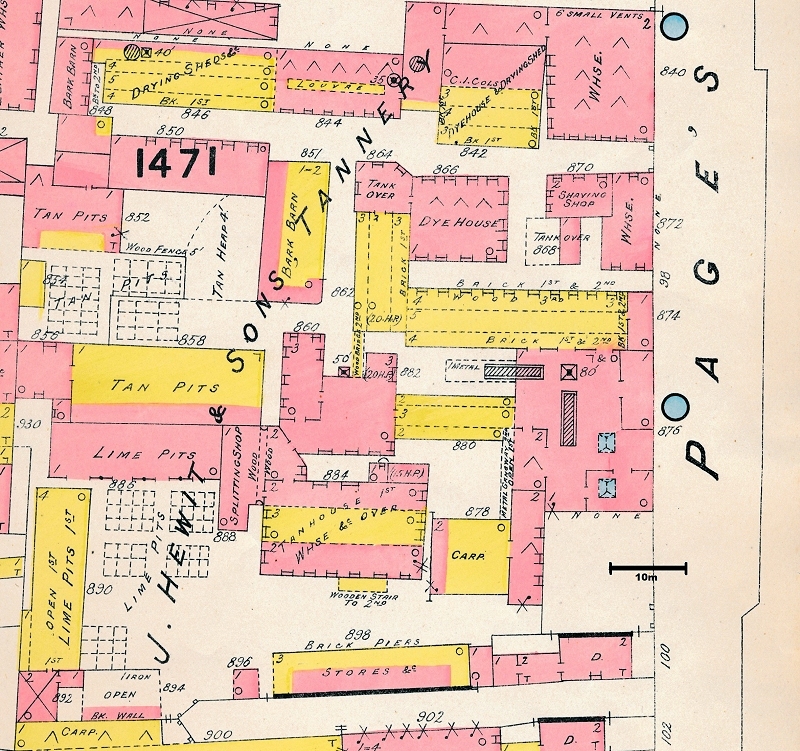
Plans of 98 Pages Walk, Bermondsey
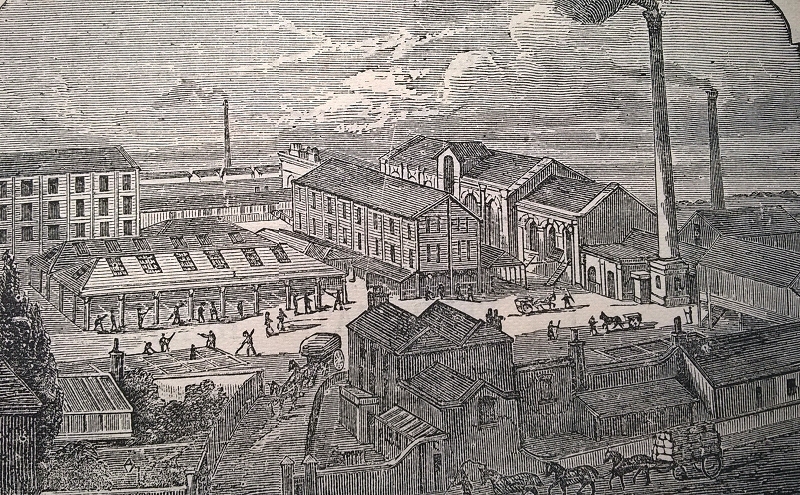
The Grange Tannery, Bermondsey
By 1800 a third of the leather produced in the UK was made in Bermondsey. It had all the right conditions for expansion - open countryside, a constant supply of water and of oak bark from the surrounding countryside; hides from the butchers of London; a plentiful supply of cheap labour, and a good market for the finished product over the river in the City. By the mid 1800's Bermondsey had turned into a notorious slum however, during the latter half of the 1800's and early 1900's, efforts were made to improve the area and a goods railway station had opened immediately behind the premises in 1866.
Bermondsey also had a famous leather market where skins were bought and sold. This was still an important place for the trade right up into the 1960's as every single skin that came out of India was sold there in weekly auctions.
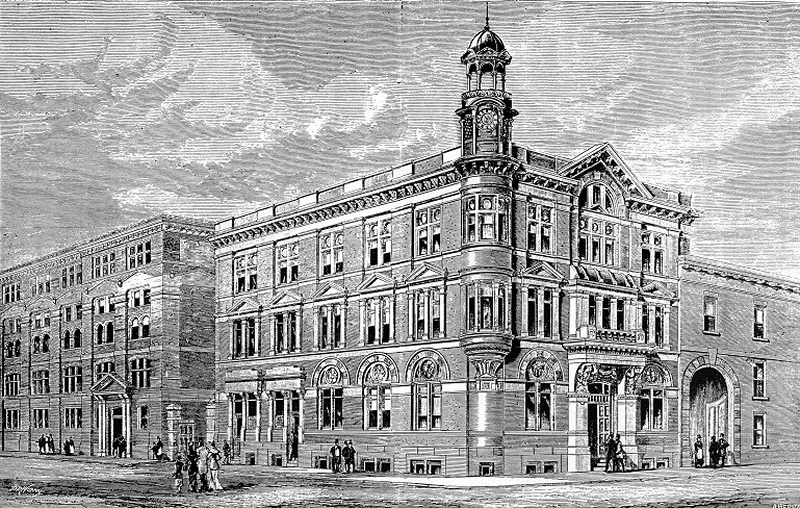
The London Leather Market, Bermondsey
My Father used to go down to the market to inspect skins prior to purchase in the auctions. Sadly, with Indian independence in 1947 combined with the reconstruction of the London docks following the war and industrial action at the ports the Bermondsey Leather Market was in terminal decline and closed in 1960's. We now purchase our Indian goatskins directly from Chennai. In 1879 Dickens described the market as follows:
Bermondsey Leather Market: This great leather, or rather hide market, lies in Weston-street, ten minutes' walk from the Surrey side of London-bridge. The neighbourhood in which it stands is devoted entirely to thinners and tanners, and the air reeks with evil smells. The population is peculiar, and it is a sight at twelve o'clock to see the men pouring out from all the works. Their clothes are marked with many stains; their trousers are dis-coloured by tan; some have apron and gaiters of raw hide; and about them all seems to hang a scent of blood. The market itself stands in the centre of a quiet block of buildings on the left hand side of Weston-street, the entry being through a gateway. Through this a hundred yards down, a square is reached. Most of it is roofed, but there is an open space lathe centre. Under the roofing are huge piles of fresh hides and sheep-skins. There is no noise or bustle, and but few people about. There are no retail purchasers, the sales being almost entirely made to the great tanners in the neighbourhood. The warehouses round are all full of tanned hides; the yards behind the high walls are all tanneries, with their tens of thousands of hides soaking in the pits. Any visitor going down to look at the Bermondsey hide-market should, if possible, procure beforehand an order to visit one of the great tanning establishments. Unless this be done the visit to the market itself will hardly repay the trouble of the journey, or make up for the unpleasantness of the compound of horrible smells which pervade the whole neighbourhood. NEAREST Railway Station, London-bridge; Omnibus Routes, Tooley-street, Borough High-street, Gt. Dover-street; Cab Rank, Bermondsey-square.
As can be seen by the image of the Learmonth & Roberts pricelist (below) from just before they closed the two tanneries were involved in very much the same lines of production of goat, calf and sheepskins. In addition Learmonth & Roberts also sold bookbinding materials in the way of "Cloth, Marble Papers, Gold, Vellums Glue & Thread", something we have continued doing to this day.
One interesting fact from the Learmonth & Roberts pricelist is that they listed three different types of sheepskins. We stopped selling bookbinding sheepskins with the demise of the UK felmongeries but even before then had become lazy in our nomenclature as we sold everything as Basils regardless of the tannage.
Roan - a soft flexible sheepskin, often treated to resemble a morocco and used in bookbinding. Generally tanned with sumac
Basil - a sheepskin tanned with a firm tannage such as mimosa and used in the manufacture of aprons for blacksmiths, cobblers, fire fighters and other artisans.
Sheep White - this was probably alum tawed skeepskins
Tragedy struck the family when in 1875 the youngest brother, Charles Murray Hewit, who appears to have had heart problems died from complications following pneumonia at the age of 32. Charles was single and his will left everything to his two brothers. The leap of faith in purchasing two tanneries looked to have been a great investment as his estate was valued at £10326. On the basis that he owned one third of J Hewit & Sons this means that the Company was worth around £3 million in today's money.
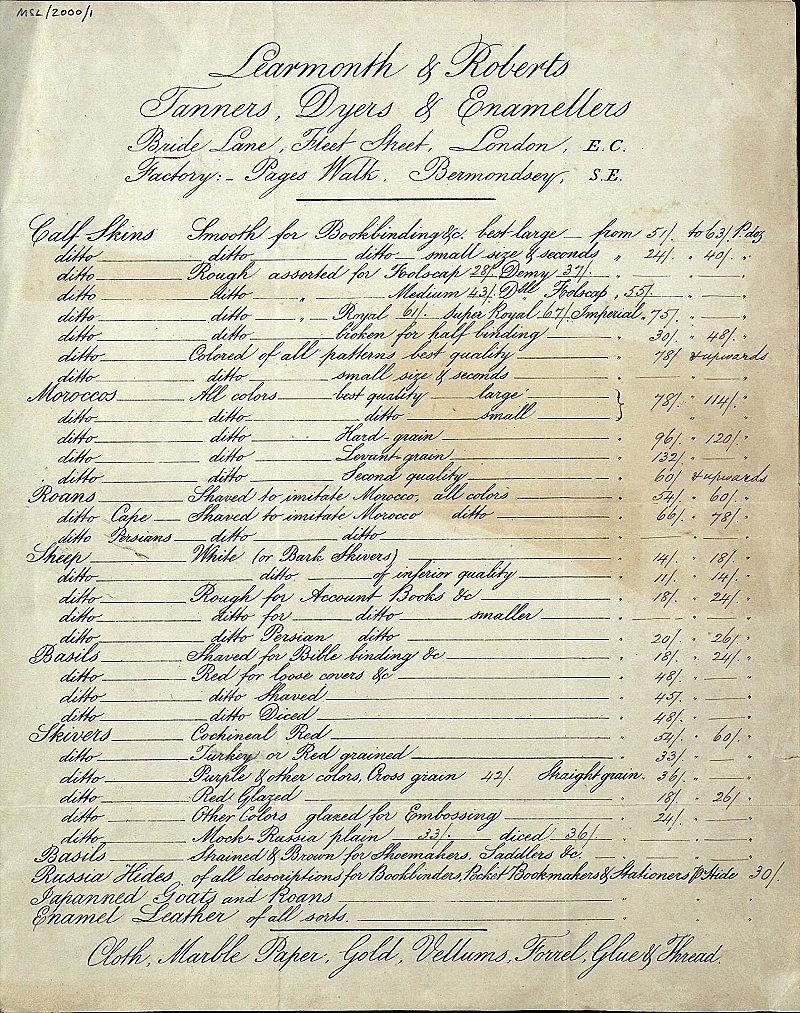
In my first article about the history of J. Hewit & Sons I had an advert from 1861 in which bookbinding leather was mentioned. By 1884 it is obvious that bookbinding supplies had become a major part of the business and it was in the Edinburgh bookcloth department that the fire started. The bookcloth was almost certainly from Winterbottoms as we were Winterbottom agents for many years. (Sadly we lost our original Winterbottoms catalogue in the fire in the Currie premises in 1991).
The fact that we were targeting bookbinders was not unexpected with the rise of bookbinding both in Edinburgh and London. Edinburgh had become the centre of publishing in the UK at the time with names such as Nelsons, Encyclopaedia Britannica, Oliver and Boyd and Chambers and in London large bookbinding houses were being established such as WT Morrell and Zaehnsdorf. The importance of bookbinding to the company can be seen in their first advert in the Bookbinder on the 18th of July 1887 (at a cost of £2/7/6).
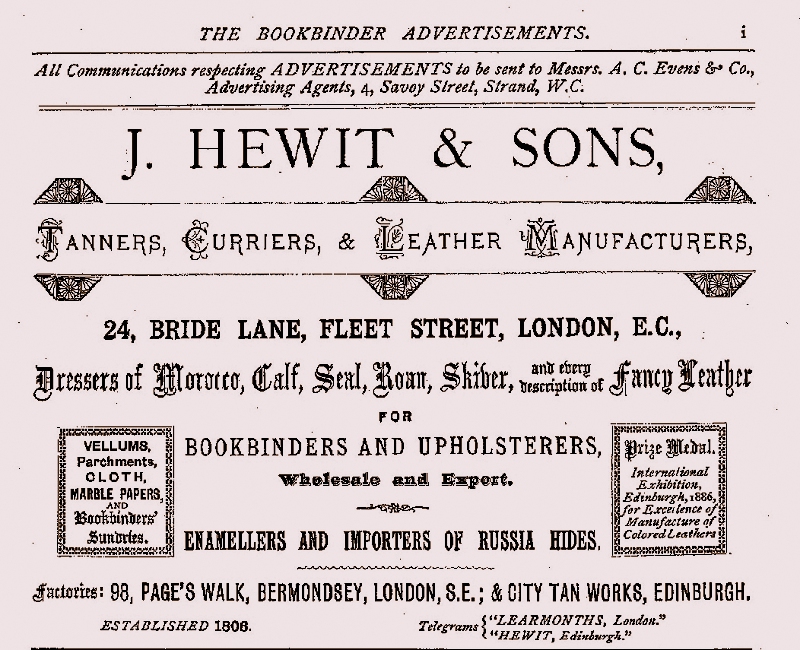
The Bookbinder advert also mentions that we were prize winners at the Edinburgh International Exhibition in 1886. The exhibition opened on May 6th 1886 in the city's Meadows parkland and ran until the 30th of October with more than forty-thousand people attending the opening ceremony. The exhibition would see the city of Edinburgh experience five months of world-wide exposure with over 2.7 million visitors.
The magnificent structure of the exhibition building took up approximately half of the Meadows, a park on the south side of the old town. The impressive main pavilion at the front of the building was topped with a 120ft high domed roof decorated with the signs of the zodiac. Beyond the main hall were numerous corridors and galleries filled with all the wonders of the Victorian age. Over 20,000 exhibits were arranged throughout a structure that could hold tens of thousands of visitors at any one time. Fascinating exhibits from around the world ranged from 'educational appliances; Italian furniture and marble; violins from Prague; Turkish embroidery; illustrations of mining, pottery, sugar-refining, sea industries, paper-making, printing, and railway, tram-way and other vehicular appliances'. The piéce de résistance, however, was undoubtedly the large-scale reconstruction of a typical 17th century Edinburgh street complete with legendary buildings that had long since been demolished. The original idea had been to leave the pavilion on the Meadows, however the whole structure was dismantled as an act of Parliament in 1827 banned permanent structures on the Meadows.
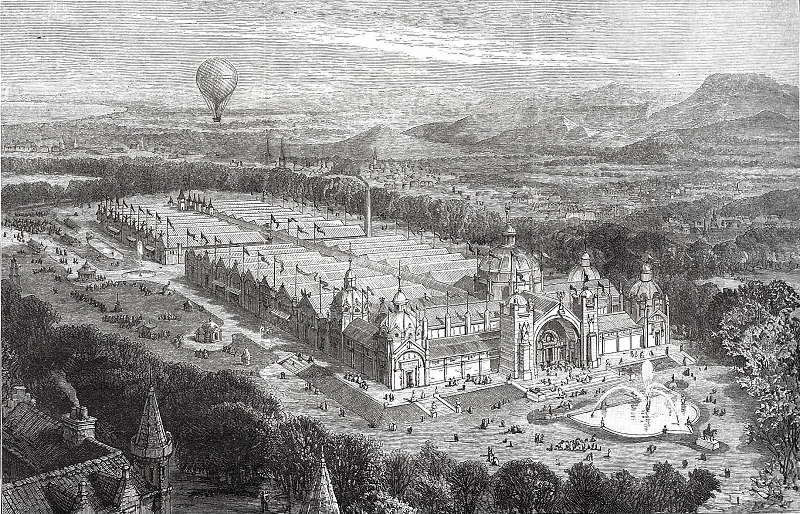
There was an event to mark the 100th anniversary of the exhibition and sadly very little now survives. We are one of the few companies who exhibited still in existence and are therefore very proud of our Diploma of Merit awarded for the excellence in the manufacture of coloured leathers.
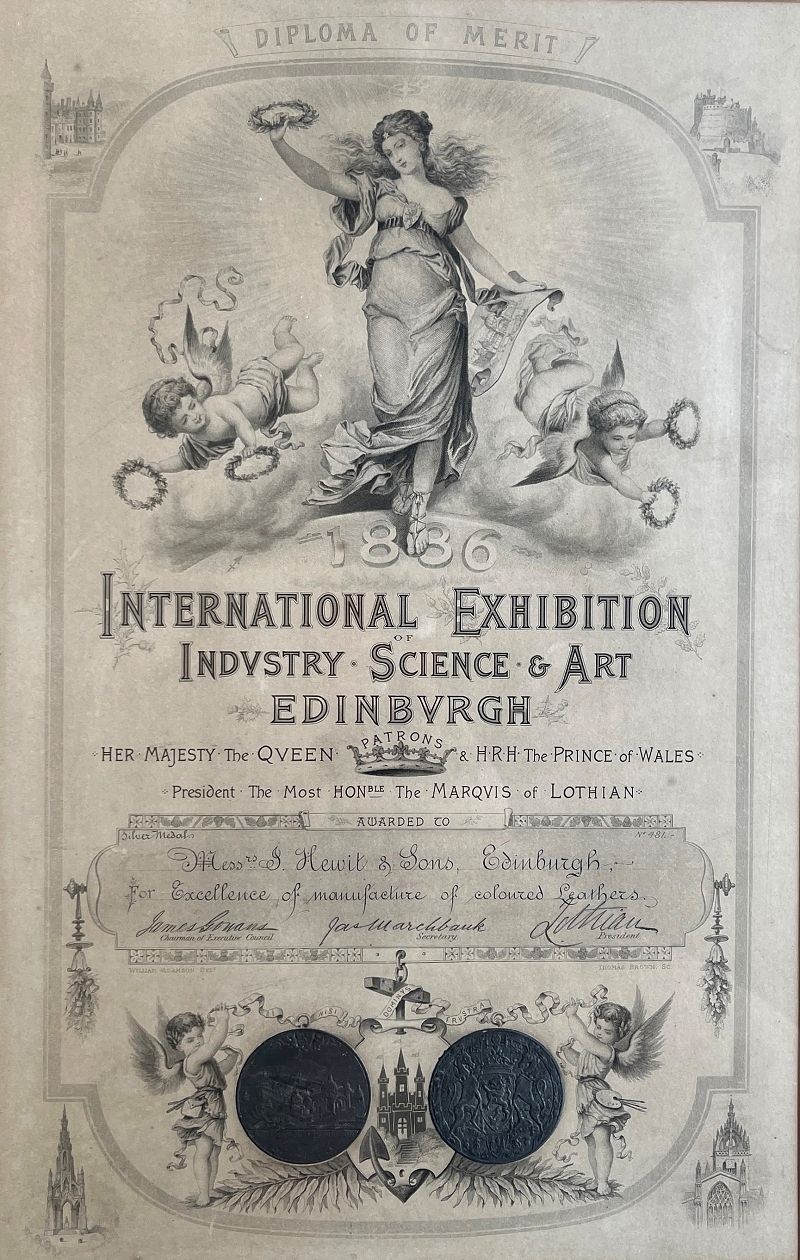
1886 and 1887 were traumatic years for J Hewit & Sons. As well as being awarded their Certificate of Excellence at the Edinburgh International Exhibition Thomas Hewit must have been suffering ill health as he was moving into the final stages of Kidney failure. One wonders if this was the reason that his younger brother David decided that he had to get married as he realised that he might soon be the last of Janet and Thomas' sons.
David aged 50 married Eliza Bourgois (31) on the 8th of April 1886. Eliza was the daughter of Benoit Bourgois of French Huguenot descent who owned the Bourgois hotel in Fleshmarket Close, 100 yards from the City Tan Works. This appears to have been, at least to some extent, a marriage of convenience in order to get an heir as there was an anti-nuptial (nowadays called a pre-nup.) agreement since when David died his wife did not inherit his estate but was only given an allowance for life.
Thomas died in Musselburgh, then a spa town on the outskirts of Edinburgh, on the 19th of October 1886 leaving David Gavin Hewit with the difficult job of running two tanneries 400 miles apart in the days before telephones.
OBITUARY
THOMAS HEWIT, Aged 56.The above named gentleman was a partner in the firm of Hewit & Sons, Tanners and Light Leather Manufacturers, Edinburgh and London. The deceased gentleman expired on the 19th Ult., at his residence, Musselburgh, N.B. He was a gentleman well known and respected outside the particular trade he was engaged in, being a Member of the Merchant Company, Edinburgh; the Chamber of Commerce, Edin-burgh ; the Caledonian Society, London, and a life governor of the Scottish Corporation, and Caledonian Asylum, London. His funeral was largely attended, amongst those present being the Deacon of the Incorporation of Cordiners, Edinburgh.
On a brighter note David and Eliza had a son, Thomas David Hewit, born in June 1887 meaning that David finally had an heir when aged 50. David himself however was not well and had been suffering from a painful illness for several months; he finally died less than 2 months later on the 1st of August at his home in Upper Norwood. He was brought back to Edinburgh to be buried with his mother and brothers in the Grange Cemetery. His obituary in the Leather Trade Circular and Review reads:
OBITUARY
DAVID GAVIN HEWIT, Aged 50.We regret to have to announce the death of the above gentleman, which occurred at his residence, Upper Norwood, in the 1st inst., after a painful illness, extending over many months.
His remains were conveyed to Edinburgh, where the funeral took place on Saturday, the 6th, and was attended by a large number of friends and members of the trade.
The deceased was the only remaining partner of the firm of J. Hewit & Sons, morocco and coloured leather manu-facturers, of Edinburgh, and Page's - walk, Bermondsey, London, and his death is all the more painful to notice, owing to the circumstance that so recently as October of last year we had to refer to the death of his brother and partner in the firm, Mr. Thomas Hewit, and it is rendered still more sorrowful by his only having been married fifteen months ago, leaving a widow and one child about eight weeks old, to mourn his loss.
The Hewits, father and sons, were hard-working, energetic but successful men. Their works at Edinburgh have been in existence about half - a - century, and their connection with London dates back to 1870, when the firm took over the busi- ness of Learmouth & Roberts, which has been established nearly 100 years now.
Mr. Hewit, whose death we notice to - day, was younger than the brother referred to, by seven years, his other brother (Charles Murray Hewit) having died in 1875, at the early age of 32.
He was rather of a retiring disposition, and although he took no active part in public affairs he was ever ready to support liberally any scheme for the benefit of his fellow men, and especially those institutions connected with the trade.
As a business man he was keen, straightforward, and up- right, considerate to his employés, frank and genial to all who came in contact with him. He was well known to many members in all branches of the leather trade, was highly respected by all, and his demise will be felt as a great loss to the trade and a wide circle of friends.
